The US has one of the highest numbers of turtle species in the world. There are over 100 species in the country distributed in some of the states. They are unevenly distributed as some states have more turtles than others.
How many turtle species are in Pennsylvania?
Pennsylvania (PA) has at least 12 turtle species. Some of them share characteristics in terms of appearances, size, lifespan and dietary behaviors. Others have different characteristics owing to their different origins. The turtle species that are found in Pennsylvania include:
- Blanding’s Turtle
- Bog turtle
- Common snapping
- Eastern mud
- Common map
- Eastern painted
- Midland smooth softshell
- Eastern box
- Wood turtle
- Northern Redbelly turtle
- Common musk
- Spotted turtle
Let’s now look at each of these turtles, their appearance, diet, nesting, size and other features that distinguish one species from the other.
1. Blanding’s Turtle (Emydoidea blandingii)
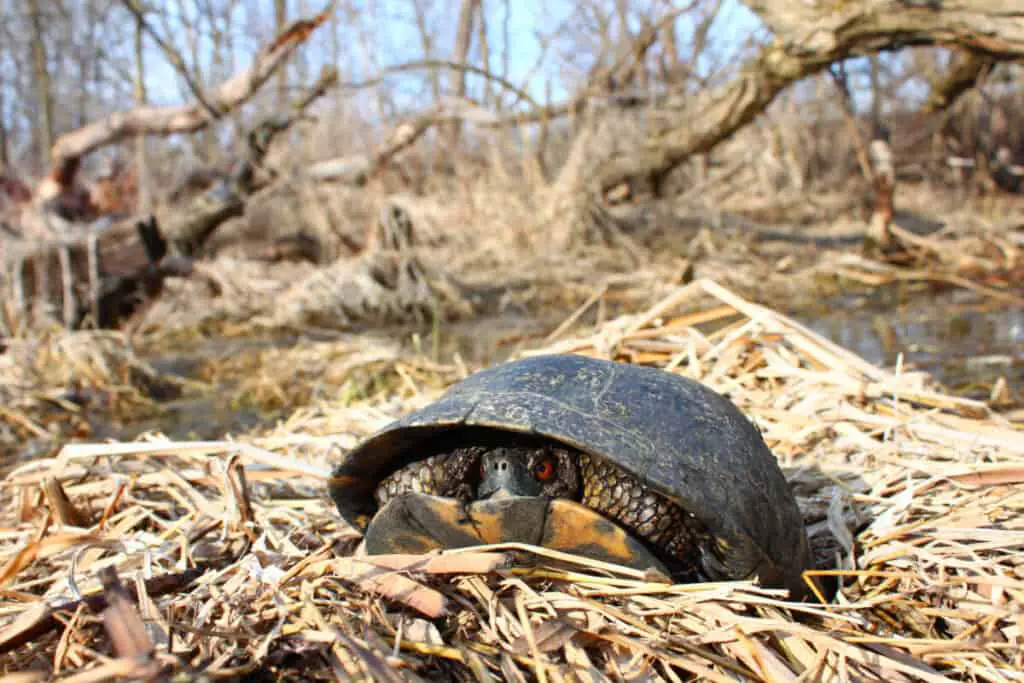
Scientific Name: Emydoidea blandingii
Description: One of the unique characters about it is that its shell is more dome-shaped compared to other species.
Blanding’s upper shell, known as carapace, is usually black or dark brown in color. The lower part of the body is yellow with some black patches. Its neck is yellow while its feet are black or, in others, dark brown. The feet are webbed to aid in swimming.
The turtle is found predominantly in poorly drained areas, marshy regions and slow-moving waters.
In terms of conservation, Blanding’s turtles are one of the endangered turtles in PA owing to their habitat destruction and increased predator threat.
Size: A mature Blanding’s turtle measures between 7 and 10 inches.
Diet: They are omnivorous, with their main diet including crustaceans, mollusks, insects and plants. They catch prey by ambushing them when they come close within striking distance.
Reproduction: Male Blanding’s turtles mature in around 12 years while the females mature by 18 years. Nesting in Blanding’s turtles occurs between the months of May and July and lasts between 70 and 90 days.
A female lays at most two clutches a year, with each clutch having between 6 and 15 eggs.
Lifespan: Their lifespan is about 80 years.
Price: For the pet enthusiasts, you will be required to part with at least $300 to acquire a Blanding turtle.
2. Bog Turtle (Glyptemys muhlenbergii)
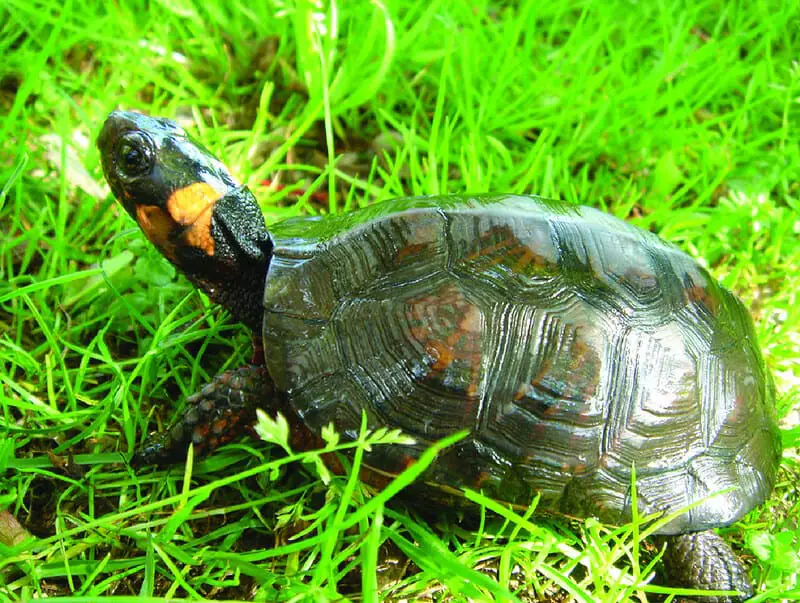
Scientific Name: The bog turtle is also known as Muhlenberg’s turtle, and their scientific name is Glyptemys muhlenbergii.
Description: They are aquatic, and they too are considered critically endangered turtle species in Pennsylvania. The major threats facing them are habitat loss and fragmentation. This has been caused by mainly land development and other activities in their habitat.
Other causes of the declining bog turtle population include the growing number of predators like skunks and raccoons that love to feed on their eggs and hatchlings.
The shells of bog turtles are keeled and range in color from dark brown to olive to black. In some of these turtles, the scutes have some red or yellow star-like patterns. They also have a distinctive bright yellow or orange patch on their heads.
This species is usually found in meadows, swampy and marshy regions and other regions with slow-moving water.
Size: Bog turtles are relatively small since they only average a mere 3 to 5 inches. They are actually the smallest aquatic turtle found in North America.
Diet: Because they are omnivorous, their diet is mainly composed of insects, mollusks, earthworms and occasionally soft aquatic vegetation.
Reproduction: Nesting happens between May and July, laying between 3 to 5 eggs in each clutch. Incubation lasts up to 90 days, depending on the condition of warmth and moisture. Sexual maturity in both males and females is achieved at around six years. This is the same whether the turtle is in captivity or the wild.
Lifespan: They have a lifespan of up to 40 years, and the longest living bog turtle ever recorded was 61 years old.
Price: Pet lovers can acquire a bog turtle for around $250, depending on its age. They are suitable for beginners, but you should know that bog turtles are considered to be slightly aggressive, with the males being more aggressive than the females.
3. Common Snapping Turtle (Chelydra serpendna serpentine)
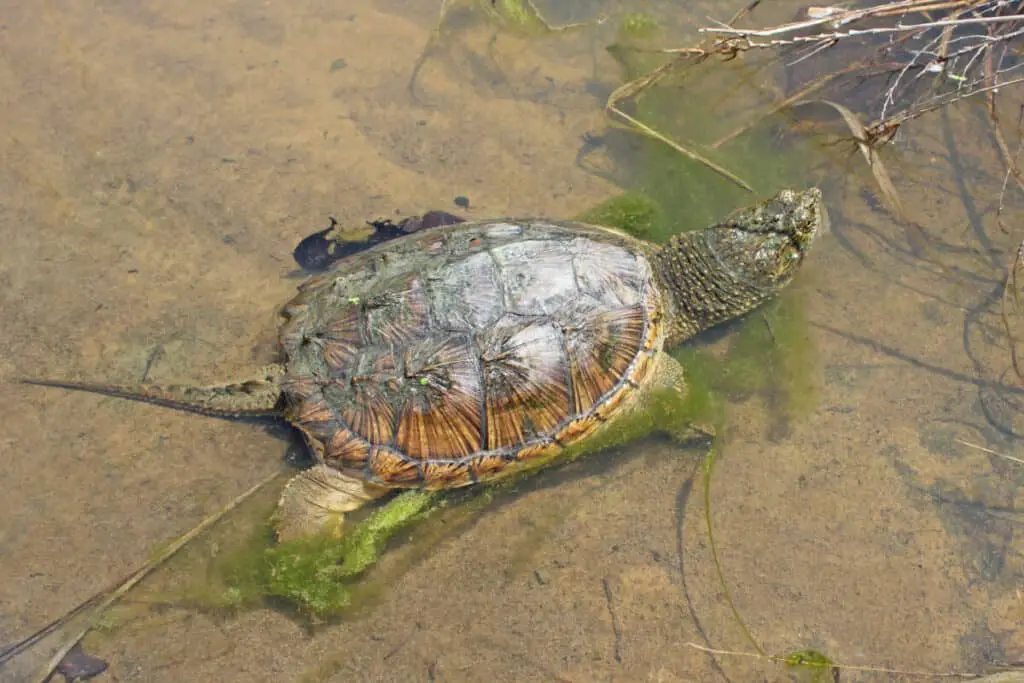
Scientific Name: Chelydra serpendna serpentine.
Description: The common snapping turtle is at times called the freshwater “loggerhead”. Its scientific name is Chelydra serpendna serpentine. This is the only economically viable turtle in Pennsylvania, as it is considered a delicacy for its meat.
PA turtle laws require turtle breeders in PA and sellers to acquire a license to participate in the trade.
Common snapping turtles are characterized by a large head and a smaller plastron in relation to the rest of the body. Their tails are substantially longer than in other turtle species.
The carapace of the snapping turtles ranges from tan to dark brown and, at times, black. It is rough and serrated, with three keels running down its length. Its plastron ranges from yellow to tan and is unpatterned.
Their necks are covered with loose warty skin that is rough to touch. A strong jaw characterizes a common snapping turtle with a distinct hook at its tip.
Being aquatic turtles, they are usually found in slow-moving water, ponds and swampy regions. They love habitats with soft mud and with an abundance of aquatic vegetation.
Size: Common snapping turtles are considered to be one of the largest turtles in Pennsylvania. A mature one measures between 12 and 15 inches long. There are recorded cases of this species measuring up to 19 inches.
Diet: Since they are omnivorous, they mainly feed on fish, amphibians, and small water birds that get too close.
Reproduction: Sexual maturity occurs between 8 and 10 years or when they achieve a length of 8 inches. Nesting takes place between May and July, where the females lay between 20 – 40 eggs per clutch and the eggs hatch in between 80 – 90 days.
These turtles hibernate in winter. Their hibernation period is between 90 and 100 days and ends in April in preparation for the nesting season.
Lifespan: Common snapping turtles live for between 30 and 50 years.
Price: Common snapping turtles are relatively cheap for those who wish to buy them as pets. With $50, you can get one or two of them. These turtles are also one of the most aggressive turtle species, and for that, petting them is highly discouraged.
Only get a pet common snapping turtle if you have rich experience in keeping turtles.
4. Common Map turtle (Graptemys geographica)
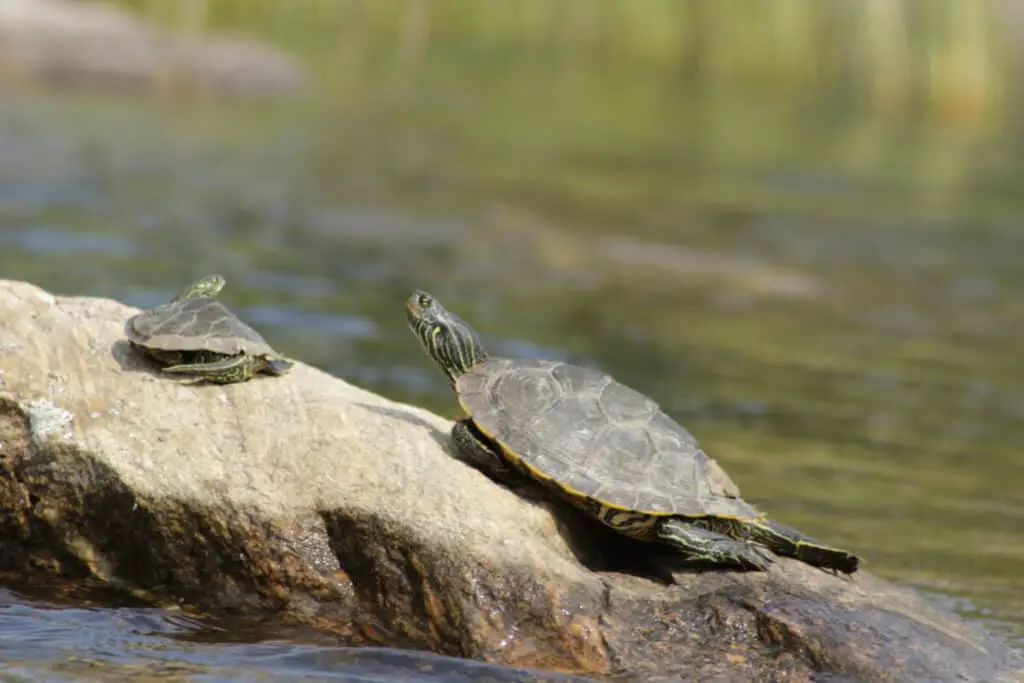
Scientific Name: Scientifically, they are known as Graptemys geographica.
Description: Common map turtles, also called the Northern map turtles, have dull colors ranging from dark brown to black. They draw their name from the map-like patterns running across their upper shell. The lower shell has lighter grey color with no distinct patterns.
Their skin has a dark green or sometimes brown color with thin yellow stripes.
These turtles are aquatic, spending most of their lives in ponds, lakes and river bottoms. They prefer areas with large water bodies with fallen trees and other debris.
Common map turtles hibernate in winter. They rarely burrow deep in the mud and thus are usually easy targets for their predators like raccoons, opossums, skunks and coyotes. Their eggs and hatchlings are not spared by these predators and others like crows, grackles, river otters, foxes, and red-winged blackbirds.
Despite all the threats faced by common map turtles and their eggs, they have a thriving population with the least concern conservation status.
Size: Female common map turtles are bigger, reaching between 8 and 10 inches, while the males only achieve 3 to 5 inches in length.
Diet: A typical diet of this species is mainly carnivorous, but some occasionally feed on some aquatic vegetation. They largely feed on mollusks, crayfish, freshwater mussels and some aquatic insects.
Reproduction: Maturity in males takes up to 6 years, while it may take up to 10 years in females.
With common map turtles, breeding happens in both the spring and fall, while nesting mostly takes place between May and mid-July. A female lays about 10-12 eggs per clutch and may lay up to three clutches in a year.
Incubation takes between 75 and 90 days, and the sex of hatchlings depends on the temperatures. Warm temperatures during incubation are known to produce more females, while cooler temperatures produce more males.
Lifespan: Common map turtles have between 30 and 50 years of lifespan, depending on whether they are in the wild or captivity.
Price: These turtles are relatively cheap pets costing between $20 and $60. They are also fairly easy to take care of and are suitable for pet lovers with little to no experience.
5. Eastern mud turtle (Kinosternon subrubrum)
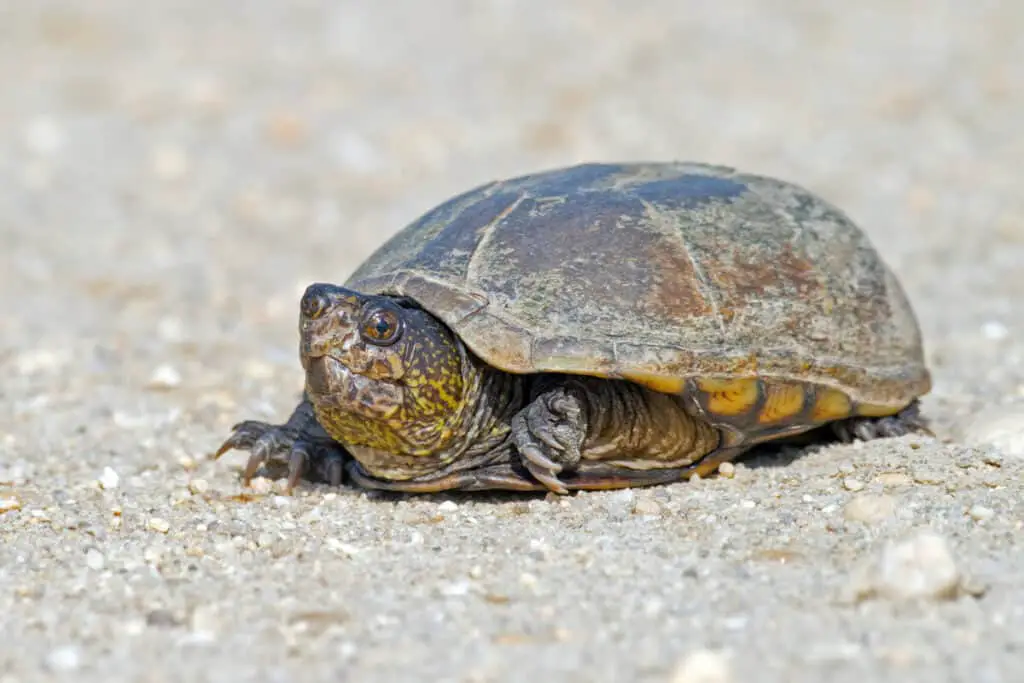
Scientific Name: Kinosternon subrubrum.
Description: Eastern mud turtles or Kinosternon subrubrum are small semi-aquatic turtles that are predominant in shallow, slow-moving waters such as swamps, bogs, and swampy marshes. They are classified as endangered turtles in Pennsylvania and are only found in the extreme southeast region of the state.
The carapace of an eastern box turtle is unmarked, smooth and oval with a brownish or yellowish color. A distinct feature is that its carapace is the 11 scutes (plates) instead of 12 in most other turtles.
Its upper shell is sharp at the edges, while the plastron is slightly larger than that of its other relatives like the musk turtle. The plastron in most of these turtles is yellow, but there are those with a brown color. Males are characterized by having rough, scaly patches on the inner sides of their hind legs.
Being semi-aquatic, these turtles spend their lives on both land and water. They are not very active swimmers but prefer crawling on the muddy bottom of ponds. In addition, they prefer slow-moving water and shallow ponds and marshy areas with lots of vegetation.
Size: An adult mud turtle reaches a size of between three and five inches, with the females being slightly bigger than the males.
Diet: These turtles are omnivorous, and their diet mainly consists of aquatic insects, seeds, mollusks and crustaceans. They also feed on the soft aquatic vegetation within their habitat.
Reproduction: Females reach sexual maturity after 5-8 years, but males take a shorter period of 4-7 years.
Eastern mud turtles hibernate on land by burrowing about two inches below the ground surface.
Breeding soon after hibernation, the females lay between 2 and 5 eggs per clutch and can lay up to two clutches every year. Unlike most other turtle species, eastern mud turtle eggs have a hard shell that does not absorb moisture. Incubation takes between 70 and 90 days. Hatching occurs in August and September.
Lifespan: Mud turtles have a lifespan of up to 50 years.
Price: A pet mud turtle costs about $50-$100 and is suitable for new pet keepers with little experience.
6. Midland smooth softshell (Apalone mutica)
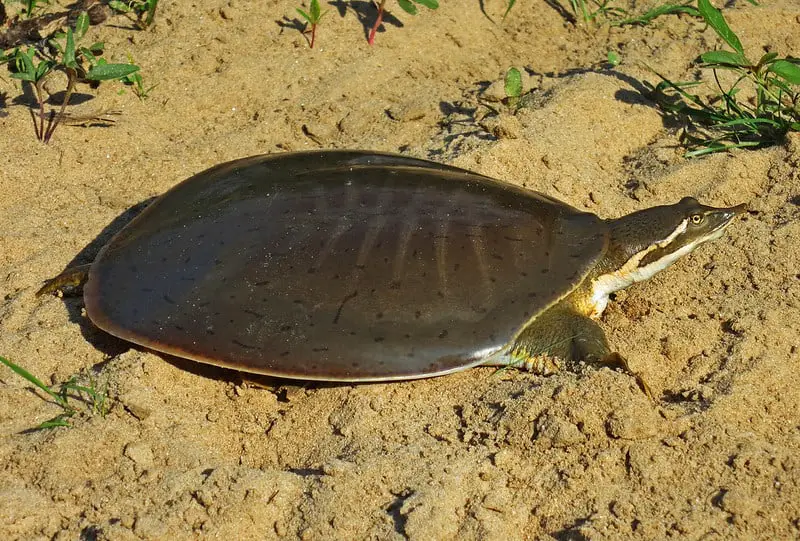
Scientific Name: Scientifically, Midland softshell turtles are called Apalone mutica. They are also called spineless softshell.
Description: As their name suggests, these turtles have plain smooth shells without any distinct markings or bumps. The color of the shells ranges from olive-grey to dark brown or tan. These turtles have a thin strips of bright yellow or grey color bordered by a black one behind each of the eyes.
Since they are aquatic, they prefer habitats with water bodies and soft grounds with mud or loamy soils. This allows them to burrow underneath when hibernating or hunting for prey.
Size: A mature midland smooth turtle measures between 6 and 13 inches.
Diet: Midland smooth turtles are considered to be omnivorous, but they have a preference towards meat as compared to plant life. Their main food sources include aquatic insects, snails, small fish, which they supplement with fruits, vegetables and seeds.
Reproduction: Nesting occurs in the months of May through July. Each clutch contains between 3 to 28 eggs, but only one clutch is laid in each nesting season. The incubation period takes between 60 to 90 days, and this happens in August and September.
Unlike in most other species, Midland smooth turtle females are known to offer prenatal care. A female produces huge amounts of non-polar liquids, which aid in embryo development. The hatchlings feed on these liquids which gives them enough energy to reach a water body once they are hatched. However, no physical care is given once they are hatched.
Sexual maturity in Midland smooth turtles occurs after the 4th year in males and the 9th in females.
Lifespan: The turtles have a lifespan of about 25 years.
Price: Owning this turtle will set you back between $40 and $60. They also require a person who has skills in taking care of turtles.
7. Eastern Box Turtle (Terrapene carolina)
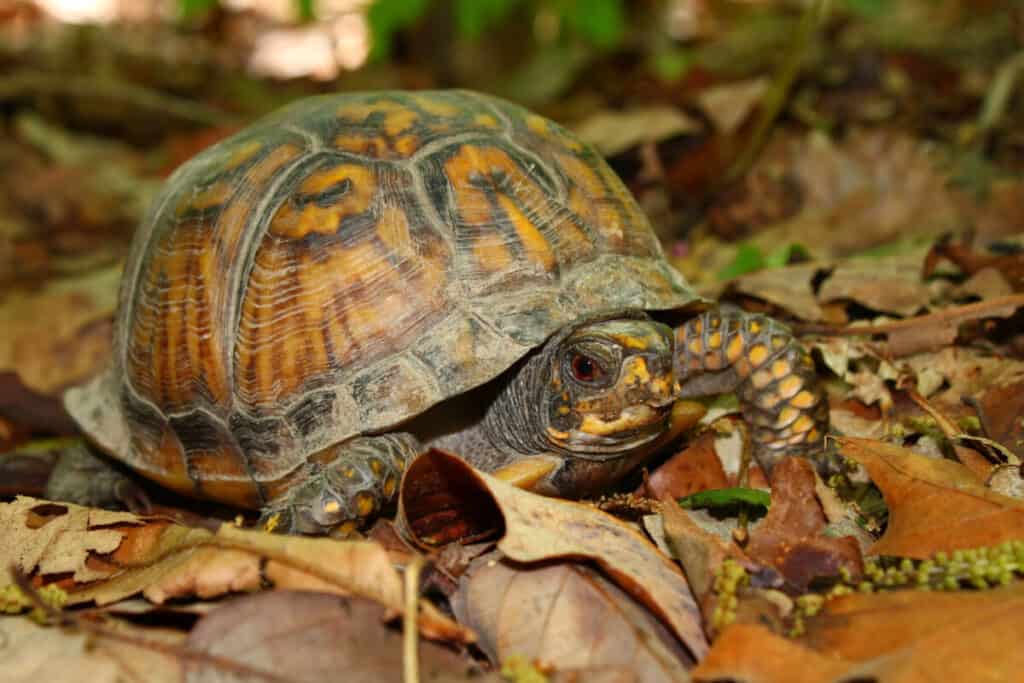
Scientific Name: Eastern Box turtle is considered the most famous turtle in Pennsylvania. Its scientific name is Terrapene Carolina.
Description: Studies indicate that the turtle population has been steadily decreasing over the years, leading to its classification as a vulnerable species.
Box turtles have a dome-shaped carapace ranging from black to brown. Despite varying color from one turtle to another, their shells have visibly unique patterns. They also conspicuous spots or blobs that are mostly yellow, orange or red.
The plastron in females is flat, while that in males is slightly concave to aid during mating. An interesting fact about box turtles is that they are able to regenerate their shells when damaged.
Size: An adult box turtle can grow up to 5-7 inches in size. They are terrestrial in nature but spend most of their lives near a water source.
Diet: Eastern box turtles are painfully slow and can only manage up to about 50 meters on the ground searching for food. They are omnivores, and their diet consists mainly of small fish, invertebrates, aquatic insects and aquatic vegetation.
Reproduction: Sexual maturity is achieved after about five years. Males are especially active in search of a female after it rains. This helps improve the chances of the eggs surviving after fertilization due to the plentiful moisture.
Their breeding period occurs between May and July. Due to the difficulties that are sometimes experienced during the mating period, females are able to store up sperms in their bodies for up to four years which means that she does not have to mate every time to lay fertilized eggs.
A female lays on average five eggs per clutch. She can lay between 1 and 5 clutches every year. Incubation takes between 70 and 90 days, and the sex of the hatchling is greatly influenced by temperatures during incubation.
Lifespan: The lifespan of Eastern box turtles is 50 to 100 years.
Price: A box turtle can be purchased for between $120 and $400. These turtles are not so demanding, and anyone with basic turtle pet skills can take care of one.
8. Northern Redbelly Cooter turtle (Pseudemys rubriventris)
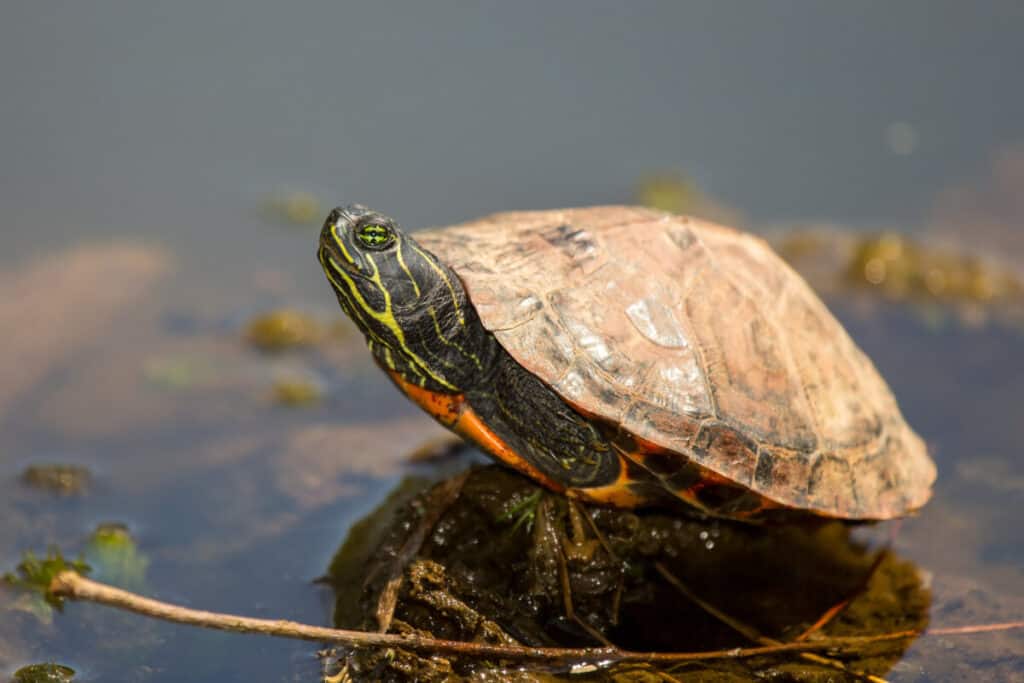
Scientific Name: Pseudemys rubriventris.
Description: Their name is derived from the red coloration of their plastrons. These turtles also have red lines running along their scutes. The shells, however, range in color from dark green to olive to black with orange markings on the edges.
These turtles have some thin yellow or, at times, white stripes on their skin and neck. The carapace is more pronounced than the plastron, making it easy for them to retract their head and limbs when threatened.
Being aquatic, their main habitat is in slow-moving water bodies or ponds with a lot of aquatic vegetation. They also prefer soft wet grounds that make it easy for them to burrow when the need arises.
Size: It said to be the largest of all aquatic turtles in North America. At a mature adult length of between 8 and 12 inches, they tower over nearly all other turtles whose average length is between 5 to 6 inches.
Diet: As primarily herbivores, feed on the aquatic plants in their environment. Occasionally, they may hunt for small aquatic animals in their environment.
Reproduction: Sexual maturity in females takes between 15 and 20 years, but it is considerably lower in males at around 5 years. Breeding occurs between June and July. A female lays between 10 and 20 eggs per clutch and can have up to 2 clutches in a year. Incubation takes 70 to 90 days, depending on moisture content and the warmth on the nest.
Lifespan: Northern Redbelly Cooter turtle’s lifespan is between 40 and 60 years.
Price: Northern Red-bellied Cooter pet turtles cost between $30 and $170 and may require some beginner skills to care for the pet turtle properly. In terms of conservation status, they are considered endangered species.
9. Common musk turtle (Sternotherus odoratus)
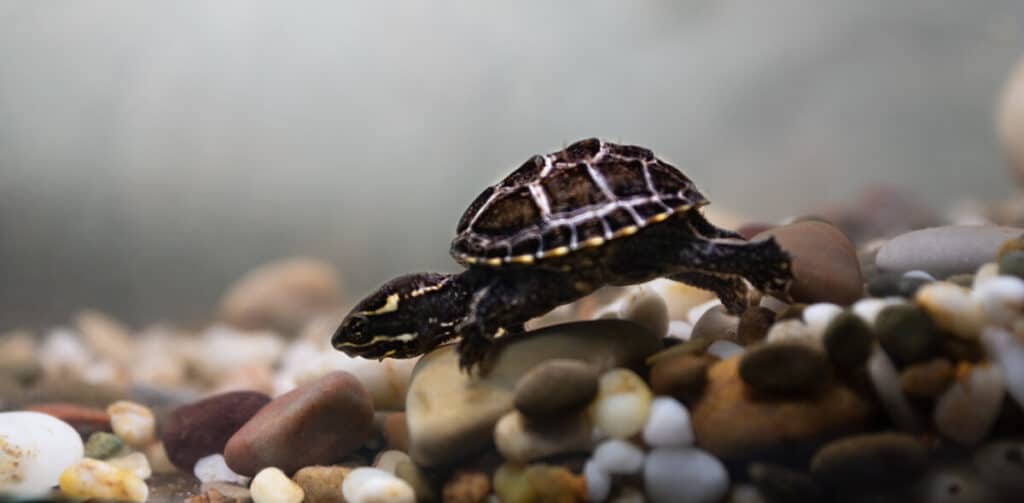
Scientific Name: Common musk turtles, Sternotherus odoratus in Latin, have a plain appearance and a uniform color for the shell and skin, usually dark brown or black. They are commonly known as “stinkpots”, owing to the strong odor they secrete when threatened.
Description: The shells of common musk turtles have a distinct ridge that transverses their whole length. Its head also has two distinct light-colored stripes that contrast the dull black or brown colors. Males have a thicker tail compared to females. They also have an extended anal vent that extends beyond the carapace.
Musk turtles are aquatic and thus spend most of their lives in the water. They are predominant in slow-moving waters, ponds, marshy areas with soft bottoms, mud, sandy or loamy soils. Rarely do they come from the water to bask.
An interesting fact is that Common musk are good at climbing trees. It is not unusual to find a musk turtle resting high in the trees.
Another characteristic of these turtles is that they are nocturnal and usually comes out to forage in the evening in shallow waters.
Size: These turtles remain small in size and relatively common in their native parts of Pennsylvania.
Diet: As omnivorous and get most of their meat from the aquatic animals they hunt. They usually feed on aquatic insects, tadpoles, mollusks, seeds and algae.
Reproduction: Breeding occurs in the spring and fall. Females lay between 1 and 9 eggs per clutch. Clutch size may at times be affected by the size of the carapace and the age of the turtle. At the time, environmental factors may also play a role. They can lay up to 2 clutches every season.
Female common musk turtles take about four years to achieve sexual maturity, while males take about years.
Lifespan: They have a lifespan of over 50 years.
Price: For those interested in having a common musk turtle as a pet, you will need to part with at least $20 and have a good understanding of what it entails to take care of a pet turtle.
10. Wood Turtle (Glyptemys insculpta)
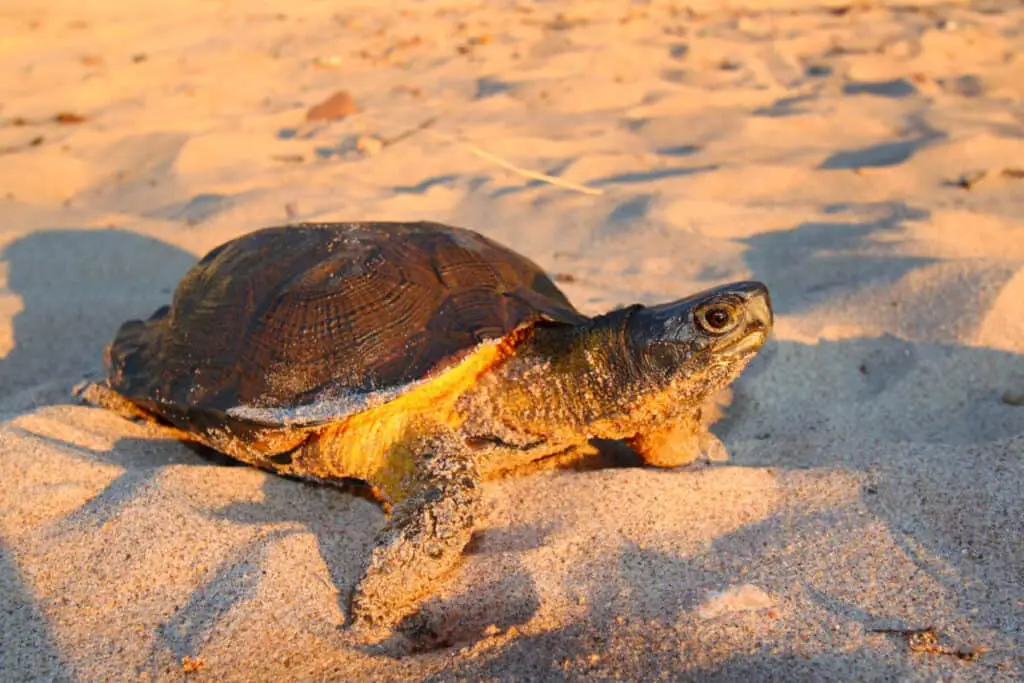
Scientific Name: Wood turtles are Scientifically called Glyptemys insculpta.
Description: They derive their name from the wood-like appearance of their rough shells. The pattern of the shell is similar to the growth rings in wood. Their shell has a pronounced dome-shaped look and is brown.
The lower part of the shell is yellow with multiple dark spots, while the rest of the body is ranges from yellow, red or orange with a few dark spots.
Wood turtles in Pennsylvania are semi-aquatic, but they never venture very far from a water source. They prefer habitats near rivers and large streams, and wetlands with moderately flowing water. The water bodies need to have a sandy or loamy bottom and, in some cases, soft mud.
Size: A mature wood turtle measures between 5 and 9 inches.
Diet: These turtles are omnivorous, and their diet includes wild berries and fruits, aquatic vegetation, algae, insects, slugs, tadpoles, worms and other small aquatic animals. They majorly roam on land to look for food.
Reproduction: Nesting happens between May and July; a female lays between and 3 and 20 eggs per clutch with a total of two clutches each year. They do this on loose soil near river banks. The incubation period lasts between 80 and 100 days.
Lifespan: Their lifespan is between 45 and 55 years. Sexual maturity in females takes 14-18 years, while it takes up to 9 years in males.
Price: Wood turtle pets are a bit expensive as compared to the rest, with one turtle going for between $250 and $500. These turtles require their owners to have good turtle pet skills to care for them correctly. They have been placed under the endangered species category due to their dwindling numbers.
11. Eastern Painted turtle (Chrysemys picta)
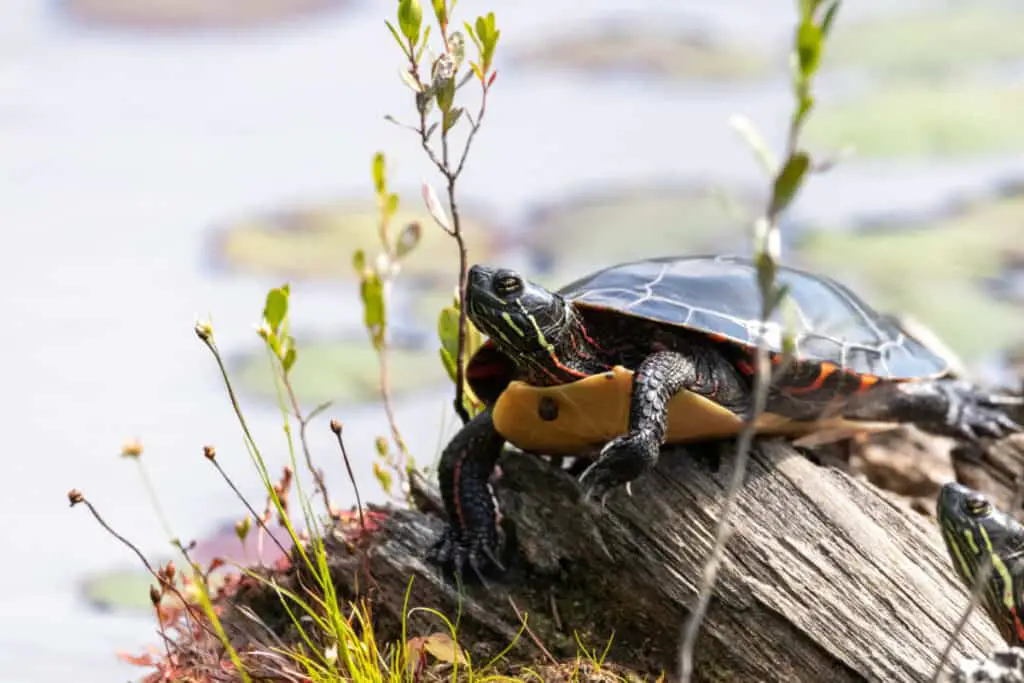
Scientific Name: Chrysemys picta.
Description: Eastern painted turtle is a mid-sized aquatic turtle. They are further divided into two subclasses; namely Eastern and the Midland painted turtles. Both are found across the state of Pennsylvania.
Eastern painted turtles have a skin color that ranges from dark olive to black. The shell is the same color as the skin, but its edges are orange, red or yellow. Its head is dark olive but with reddish or yellowish stripes.
Eastern painted turtles have a lighter color along the edges of their shells as compared to the Midland ones. Midland painted turtles can be distinguished from the Eastern ones by a shadow-like patch at the center of their plastrons.
Being aquatic, they are predominantly found in wet areas with slow-moving water. They can also be found in ponds, lakes and other marshy regions with soft mud.
During winter, this turtle hibernates by burrowing under the soft mud in shallow ponds.
Size: A mature eastern painted turtle measures between 4 and 10 inches.
Diet: They are omnivorous and rely mainly on small aquatic animals plus algae for their survival. They feed on insects, crustaceans, small fish and other small water creatures. They will also feed on aquatic vegetation whenever it is available.
Reproduction: Breeding in painted occurs in April through June. Females lay eggs from May to July. The average clutch size ranges between 4 to 10 eggs. The incubation period takes between 70 and 80 days for the eggs to hatch. Sexual maturity is between two and nine years in males and six to sixteen years in females.
Lifespan: The lifespan of Eastern painted turtles is on average 20-40 years. However, in captivity, the turtle has been known to survive for over 50 years.
Price: A painted eastern turtle pet costs between $20 and $50. They are relatively low maintenance, and beginner turtle pet owners can ideally manage to take care of them.
12. Spotted Turtle (Clemmys guttata)
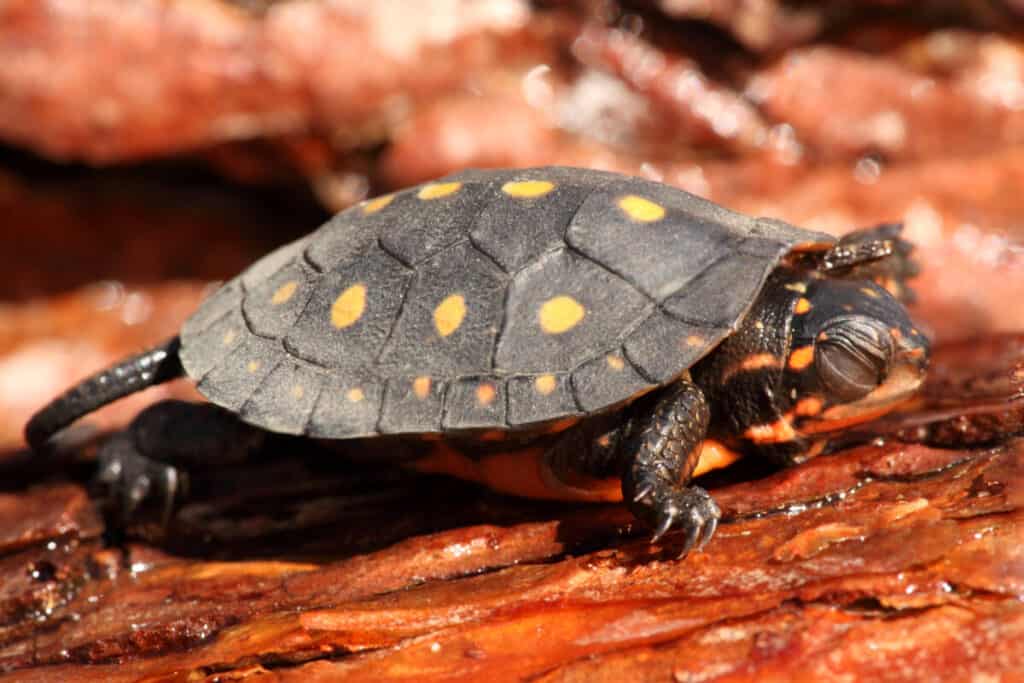
Scientific Name: Scientifically, the spotted turtle is known as Clemmys guttata.
Description: The upper part of its shell is smooth and black or bluish with round yellow spots. The spotting extends to its skin, on the tail, neck and limbs.
The lower side of the shell is yellowish-orange, while each scute has a dark color. It is also concave in males while flat in females. Mature male spotted turtles have longer and bigger tails as compared to females.
They are commonly found in marshy regions, swamps, ponds and slow-flowing rivers, streams and wet meadows. The turtles prefer wet grounds and soft mud or loamy soils.
Size: Spotted turtles measure between 3 and 4 inches in length. They are among the smallest of all aquatic turtles in the US.
Diet: These turtles are inherently omnivores. Their diet consists of soft aquatic vegetation, water lily, algae, invertebrates, amphibian eggs, worms, mollusks, small fish and aquatic insects. They are also prey to two main animals, that is raccoons and muskrats. They evade them by burrowing deep in the mud when startled.
Reproduction: Mating in spotted turtles in the months of March through May. Nesting happens in May and June. A female spotted turtle will lay on average eight eggs per clutch and may lay up to two clutches in a year.
Incubation takes between 40 and 85 days, and hatchlings start emerging in late August. Females achieve sexual maturity by the 14th year, while it is earlier in males.
Lifespan: The lifespan of a spotted turtle is between 60 and 150 years.
Price: A hatchling will cost between $75 and $90. They do not require much attention, but basic petting skills will be required.
Conclusion
The above are the turtle species in Pennsylvania. From the list, a good number of them are under the threat of extinction if the necessary measures to conserve them are not put in place.
Apart from increased predators, the other greatest and more immediate threat is from human activities.
Development and encroachment of riparian land through human activities have led to massive destruction of the breeding ground of most turtles, especially the aquatic ones.
It is, therefore, important to create awareness of the importance of conserving the turtle habitat. This will go a long way in saving their dwindling populations.
The state of Pennsylvania has also outlawed the domestication of some species in a bid to lower their demand.
Low demand ensures that these species are not hunted to be sold. This will, in the long run, stimulate growth in their populations.
Learn more about other turtle species:
- Turtles In Oklahoma (17 Species Guide)
- Turtles In Maryland (Full Guide With Pictures)
- Turtles In Alabama (30 Species with Pictures)
- Kentucky Native Turtles (17 Species With Pictures)
- Indiana Native Turtles (Ultimate Guide With Pictures)
- Michigan Native Turtles (10 Species with Pictures)
- 18 Native Turtles in Tennessee (Guide With Pictures)
- Common Turtles Species in Massachusetts
- Turtles In South Carolina (20 Species With Pictures)